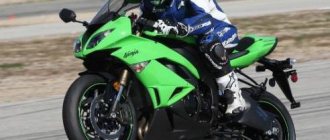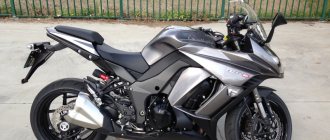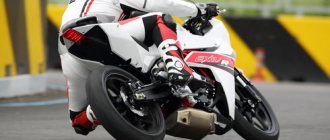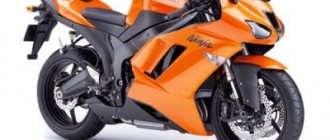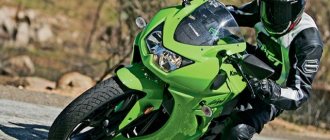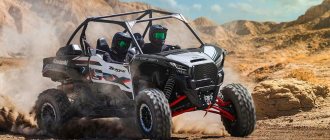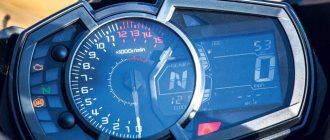The Kawasaki ZX 6R sportbike celebrates its anniversary in 2022 - the model has already turned 25 years! During this time, nine generations have changed, several engines, a bunch of different designs... But the daring and at the same time confident character for which this motorcycle was loved by tens of thousands of bikers has remained the same. Moreover, the sportbike has not undergone any significant changes in recent years, and stability is a sign of quality! So in our review we will mainly talk about the most common modification, which in a broad sense includes copies of the last two generations - they are the ones most often found both on the roads and in showrooms selling used motorcycles.
Design
The Kawasaki Ninja 600R is easy to distinguish from other sportbikes - the sly squinting of the headlights, the aggressively raised tail , the elongated silhouette, and, of course, almost always the green color . All generations of this model, except the oldest, are somewhat similar to each other, and this plays into their hands. Any experienced motorcyclist will immediately recognize a Kawasaki ZX6R if they see it, and bikers often fall in love with its appearance once and for all.
Specifications
The Kawasaki ZX600 has always performed confidently in its class, and it is always ready to show its competitors who is boss on the road. The combination of crazy dynamics and tenacious brakes has given it a reputation as a “bike with an angry character”, but in reality you just need to know how to handle it. Technical characteristics are the main advantage of this model, along with design.
Engine
Now only versions with a 636 cc in-line “four” liquid-cooled engine with a power of 130 hp and with a maximum torque of 71 Nm . But over the past two decades, Kawasaki ZX6Rs have been produced with both 599 cc and 636 cc engines, even if they bore different names in the markets of different countries. Their power varied from 105 to 136 hp. , and torque - from 65 to 71 Nm . The maximum speed for all Kawasaki ZX6Rs is approximately the same, from 248 to 264 km/h , and acceleration from 0 to 100 km/h ranges from 3 to 3.6 seconds .
Transmission
All generations are equipped with a 6-speed transmission a quickshifter was added in 2022 . Why improve something that already works perfectly? This is not the Zizer, which is famous for its problems with the gearbox. Gear shifts perfectly, almost silently, and you can completely forget about false neutrals.
Chassis and brakes
All Kawasaki ZX6Rs deservedly enjoy the reputation of bikes that can brake at 5+. This is true, but ABS began to be installed only in 2013, and then only as an additional option for a fee. Without this system, it is easy to over-brake, and this feature is worth keeping in mind for less experienced bikers. On modern Kawasaki Ninja 600 ZX 6R, two 310 mm brake discs with radial 4-piston calipers at the front and one 220 mm disc with a 1-piston caliper at the rear, so the rear brake traditionally plays the role of an auxiliary brake. The suspension is fully adjustable, and its correct setting based on the rider's weight and riding style is very important.
Electronics
Despite the presence of auxiliary electronic systems, the electrical circuit of the Ninja ZX600 is not overcomplicated. If desired, any more or less experienced motorcycle mechanic can figure it out if necessary, for example, to install an alarm or GPS tracker. If you have problems with ABS or other original assistance systems, it is best to contact your nearest Kawasaki dealer.
Weight and dimensions
The 600 cc Ninja can be called a fairly large motorcycle by class standards. Its dimensions are comparable to a “liter”, and thanks to the saddle height of 830 mm, not everyone can reach the ground with their feet while sitting on it. The curb weight of the bike varies from 191 to 206 kg , depending on the year of manufacture and configuration.
Controllability
Excellent maneuverability is one of the strengths of this model. The motorcycle obeys the steering wheel equally well at speeds of 20 km/h and 200 km/h, and behaves very predictably. This is probably due to the competent weight distribution and the calm nature of the powerful engine, thanks to which you can keep this power under control.
Fuel consumption
This parameter greatly depends on the year of manufacture and the technical condition of a particular instance. Old carburetor versions are more voracious than modern injection ones; their average fuel consumption reaches 6-6.5 liters . Injection modifications, especially fresh ones, consume about 1 liter less, but it is better to fill them with AI-95 instead of AI-92.
Motorcycle price
The oldest copies, released back in the 90s, can be found for approximately 150 thousand rubles . Oddly enough, you come across very “alive” old people, however, there is still much more motorcycle trash killed to the point of firewood. And the Kawasaki Ninja 600 ZX 6R of the last two generations will easily cost 300-350 thousand rubles or more.
Powerful and faster
Among the currently popular motorcycles from the Japanese company Kawasaki in the development of the ZX-6R, the frontal drag coefficient is characterized by the lowest value.
If the vehicle reaches a speed of 250 km/h, the low drag adds an additional 10 horsepower to the engine.
The suspensions are equipped with a full set of adjustments and are perfectly designed for the track and any roads .
Regardless of the quality of the road surface or the congestion of the route, the fairing will provide effective protection from the wind .
The motor mounts and pendulum stiffness have been retuned.
The result of this technical solution was an increase in the ease of cornering.
Repair and tuning
In terms of maintenance costs, new Kawasaki motorcycles are comparable to old ones. In some ways, the situation with them is even simpler - there is a lot of tuning, and spare parts are not difficult to find. Representatives of the first generations also have everything they need, but sometimes you have to look hard.
Repair
Self-repair is possible, and in motorcycle repair shops workers are usually very familiar with this model. If you don’t have a lot of money, of course, go to the dealer to change the oil, but in practice there is no need for this. So most owners stop visiting dealerships as soon as the warranty expires.
Spare parts
The cost of spare parts for the ZX600R of all generations is approximately the same. Usually everything is in stock, except for some rare parts that rarely fail. And on numerous owner forums you can often find extensive flea markets where you can buy and sell everything, from elements of a plastic body kit to an assembled engine.
Tuning
The amount of tuning officially released for this model is small, and it is quite expensive. But this is only if you look at the official Kawasaki catalog! But there is a lot of different stuff from third-party manufacturers from the USA, China, Japan and other countries, and it usually costs moderate money.
Competitors
Japanese engineers set themselves the goal of creating a bike that could have truly sprinting capabilities. At that time there was huge competition among manufacturers of racing and sports motorcycles.
And although the Japanese brand Kawasaki is the most dominant manufacturer, in many ways the Italians or the Germans from BMW were breathing in the back of the Japanese, introducing two-cylinder boxer engines. The latter had the ability to double the speed at the right moment.
Motorcycle modifications
- ZX600F (1995-1997). The very first model in the line. Equipped with a Ram-Air inertial pressurization system.
- ZX600G (1998-1999). Restyling with new carburetors and improved front brakes.
- ZX600J (2000-2002). Modified and slightly strengthened engine, improved electrics and different wheels.
- ZX636A (2002). Modification with increased to 636 cc. see engine size.
- ZX-6RR (2003-2004). A different appearance and many technical changes.
- ZX636B (2003-2004). In many ways similar to the above modification, but differs in a different design.
- ZX-6N , aka ZX-6R 636 (2005-2006). Another restyling, increased maximum engine speed, power 130 hp. Engine capacity is 636 cubic meters instead of 599.
- ZX-600P (2007-2008). Return to the 599 cc engine, deeply reworked.
- ZX-600R (2009-2012). Updated design, new fork and slipper clutch. In 2013, production of a version with a 636 cc engine began in parallel.
- ZX-6R 2019+. It is a restyling of the 2013 model, differing mainly in appearance. Still in production today.
What do the owners say?
Judging by the reviews from the owners of such bikes, there is little difference between a new version and a used one in good condition. However, even used owners still advise buying a new car if possible.
It is not always possible to fully understand how the previous owner used the motorcycle. And this affects its future condition, maintenance and safety of the rider.
It was noticed that the bike picks up speed well and passes through oncoming air flows, but its handling is not the best in its class. However, this is sufficient to enjoy a more or less comfortable and safe ride at not the highest speeds.
Owners also note that this bike has a convenient instrument panel, which is clearly visible in the dark and fog. You don't have to bend over to see the indicators. And this is critically important at high speeds, as is clear from any first-person video on a sportbike.
In conclusion, it is worth noting that the Kawasaki ZX-6R (636) is suitable for sports class connoisseurs. Especially if you like modern bikes and not the sports classics of the eighties. The car is responsive and expressive. But you can only do this after a weaker sportbike, so as not to get into a dangerous situation.
Advantages and disadvantages
Most sports 600s are characterized by sluggish traction at the bottom, an uneven torque curve and other features characteristic of powerful forced engines of small cubic capacity. But the Kawasaki Ninja 600R is somewhat different from its competitors in this matter.
Advantages
- Excellent brakes , especially on new models equipped with ABS.
- Efficient suspensions , energy-intensive and reliable.
- Good dynamics and decent traction even at low revs.
- Sturdy frame making the Kawasaki ZX6R suitable for stunt use.
Flaws
- Front fork seals often begin to leak . The problem is eliminated by replacing them with new ones (complete with anthers).
- Ill-conceived ergonomics : when braking sharply, the pilot immediately slides forward due to the noticeable angle of inclination of the upper surface of the gas tank.
- The exhaust pipe heats up my right leg very much, which causes discomfort.
- hydraulic tensioner requires attention from time to time, as it sometimes fails.
Owner reviews
I myself ride a Yamaha P6, I borrowed Ninja from a friend for a ride for a few days. The motorcycles feel completely different, the Yamaha is noticeably angrier, the dips and pick-ups in the torque curve are more pronounced. Kava’s character is calmer, more predictable, the dynamics are also a little more modest, but here the difference is more at the level of sensations, split seconds count. In general, I liked the Kavas more, I even had thoughts of replacing the old P6 with a new evergreen one, the prices at dealers are adequate, and they give a loan on normal terms. Vladislav, Moscow.
For several years I dreamed of a fresh Ninja ZX 10R, in the end I got tired of trying to save up the required amount and in 2022 I bought a new Kawasaki Ninja ZX 6R, switching from a Phaser-six hundred. After my first trip on an open road, I realized that it was probably for the best that I never bought a ZX10R - the six hundred is tearing up so much that it becomes scary, the steering wheel is being torn out of my hands. I’ve hardly ridden sports myself, I can’t compare it with my competitors, but even after two seasons and 20+ thousand km I still can’t shake the feeling that I’m not riding a motorcycle, but a rocket that, due to someone’s oversight, was launched into streets. Dmitry, St. Petersburg.
For five seasons I owned an old Kawasaki Ninja 600, 2001, the bike is fire! The brakes are simply dead, in the sense that you pressed them - and that’s it, you’re standing there, it’s very easy to over-brake and fall apart if you’re not used to it. There is no ABS, but there are double disc brakes at the front with 6-piston calipers that KAMAZ can stop. Well, the carbs do their job, you unscrew the handle, and after a quarter of a second you get the feeling that you are at a rodeo trying to tame some kind of wild bison, pumped up with cocaine and tequila. A motorcycle with character, it’s definitely not for beginners; you can kill yourself on this one. Leave the classics to connoisseurs =)) Anatoly, Krasnoyarsk.
FAQ
- Are the spare parts for the 600 cc and 636 cc models interchangeable or not? Different sources give different answers. Partially. Even in terms of the engine, some parts are the same, but not all.
- Is it worth catching the old supercharged modification at an auction, or is it really of little use in terms of adding power? I plan to use the motorcycle mainly on the track. The Ram-Air system provides an increase in power, but only slightly, and only at high speeds. If you do not engage in road racing motorcycle racing at a professional level, its presence or absence is not critical.
- Is ABS installed on all new copies? Or is this an additional option for a fee? Second option. Dealers still have both versions with and without ABS on sale.
Optimization process
The next task for the developers was to achieve maximum harmony between the three positions that determine the main parameters of the motorcycle. These are the athlete's seating position, ease of control and engine dynamics. In road racing mode, the driver must sit in the saddle like a glove. Any movement, even a few millimeters, will inevitably disrupt the usual control of the motorcycle, speed will be lost, and after this the prize place will be lost.
The seat shape has been optimized, the cushion has been made more rigid, the rear suspension swingarm has been moved back slightly, resulting in a more stable seating position. Now the pushes of the rear wheel did not reach the rider, he was not thrown up on every bump, his hands merged with the steering wheel, and the accelerator handle allowed him to maintain a connection with the motorcycle at the level of complete mutual understanding.
Conclusion
Belonging to the mid-sized category does not make the Kawasaki Ninja 600 worse than its “liter” counterparts and competitors. It's just a different bike, and one that can compete with more powerful sportbikes in most situations. On the track, of course, this is a completely different class, but during everyday driving around the city or on the highways there is practically no difference. More precisely, there is a difference in dynamics, but it begins to be felt only at high speeds, which even the most desperate pilots do not reach every day. This Kawasaki motorcycle costs significantly less than any “liter”, but it can give no less adrenaline.
Specifications
| Maximum engine power: | from 105 to 136 HP |
| Torque: | 65.0 - 71.0 Nm |
| Working volume: | 599 cm³ – RR version, 636 cm³ – 636 cm3 version |
| Motor type (cylinder arrangement, number of strokes): | 4-cylinder, 4-stroke, in-line |
| Number of cylinders: | 4 |
| Number of valves: | |
| Intake type (Injector / Carburetor): | |
| Bore and stroke: | |
| Starting system (Electric starter, kick starter): | |
| Maximum speed in km/h: | 248-264 km/h |
| Cooling system: | Liquid |
| Transmission (gearbox): | 6-speed, manual |
| Clutch (Dry / Wet): | |
| Drive unit: | Chain |
| Frame: | Aluminum |
| Chassis | |
| Suspension (front/rear travel): | |
| Brakes (Front/Rear): | |
| Wheels / Tires / Rubber: | |
| Dimensions and weight | |
| Dimensions (Length / Width): | |
| Seat height: | |
| Ground clearance: | |
| Curb weight: | |
| Wheelbase: | 1390 - 1415 mm |
| Weight: | 188 - 206 kg |
| Fuel tank capacity: | 17 - 18 l. |
| Battery capacity: | |
| Year of release: | |
| Country of Origin: |
Chassis
The motorcycle is equipped with shock-absorbing mechanisms with increased travel:
- front suspension - telescopic fork of reverse design, standard offset, stay diameter - 39 mm;
- rear suspension - articulated pendulum with two hydraulic shock absorbers and damper springs;
- drive for transmission of rotation to the rear wheel - chain, open type;
- brakes on both wheels - ventilated disc brakes, four-cylinder calipers; the diameter of the front discs is 310 mm, rear – 220 mm;
- front tire, size - 120/70ZR17;
- rear tire, size - 180/55ZR17;
